REGISTRO DOI: 10.69849/revistaft/cs10202410291915
Bruna Amorim Monteiro dos Santos1
Ana Paula Dário Zocca2
Abstract
Communication is necessary all the time within an organization, whether for training, a meeting, or even a small instruction, good communication is essential. The most important aspect of communication is not just what the communicator is saying, but how the listener is receiving that communication and whether it is assertive enough to lead to exactly what was requested; otherwise, it can result in rework for both parties.
Communication is fundamental for any type of organization; however, when it is done incorrectly, it can harm the productivity of employees and consequently the company’s results. Thus, this research aimed to identify the communication channels between leaders and subordinates, the impacts on subordinates’ productivity, and areas for improvement to achieve more assertive communication within organizations.
This research highlights the importance of communication, but also the assertiveness of this communication between leaders and subordinates. In this way, it was concluded that there is a need for measures to improve the assertiveness of communication in organizations, in order to achieve goals and objectives.
Through research with 24 interviewees, who work as leaders and subordinates in large multinational companies in the city of São Paulo, it was observed that assertive communication is extremely important and can have a positive or negative impact on their activities.
Keywords: business communication; assertive communication; leaders and subordinates.
Introduction
In this research, the importance of having assertive communication in organizational behavior will be addressed, primarily proving that it has a direct impact on professional productivity.
The role of business communication has led to the development of different management models within organizations, which are essential in defining workers’ behavior and productivity in a company. Therefore, communication failures from managers make us reflect on the importance of assertive communication, especially in complex situations that every organization experiences or might experience.
The word communication, from the Latin “communicare,” means to share or make common.
Communication is not merely what we say, but rather what the listener understands. And although this phrase is a ‘cliché’ in communication, it remains a significant challenge to recognize this fact. When the communicator speaks, in any medium, their thoughts are clear on what to say and/or explain; however, the listener may be subject to various external and internal factors that make it difficult to comprehend the exact same meaning.
Business communication is defined as being present in all types of organizations, whether public or private. Communication can occur in written, oral, or electronic form, and it can be conducted in an organized or disorganized manner. In organizations, communication is either planned or unplanned. (TAVARES, 2010).
In fact, it is impossible for an organization to exist without communication. If there is no communication, leaders cannot provide instructions for their subordinates to carry out their tasks. Therefore, “every act of communication influences the organization in some way” (DAVIS; NEWSTROM, 1996, p. 5).
Communication within companies is becoming an increasingly greater challenge. In addition to technology, we are dealing with various different work environments, including remote work, with much interaction happening through video calls, phone calls, and emails. Today, more than ever, communication within organizations is an aspect that must be carefully addressed, especially identifying the need for specific training and development for leaders. If there are any communication failures or areas for improvement, they need to be adjusted as soon as possible to minimize the impact on the organization.
The definition of assertive behavior in communication involves expressing emotions, preferences, needs, and opinions that the communicator holds while ensuring the listener feels comfortable. In other words, an assertive communicator respects the listener’s rights, even if that means limiting their own. The assertive communicator is able to express their opinion clearly but with the sensitivity not to appear aggressive to the listener (SILVA; BONDILI; LA CUEVA, 2011).
Communication between leader and subordinate is an even more delicate process because, before being a good communicator, it is essential to be a good listener. In many instances, there is difficulty in communication because understanding the listener requires emotional perception—being aware of what is happening internally and determining the appropriate behavior for the situation. Therefore, in order to have this perception, applying the strategy of being a good listener is crucial.
Davis and Newstrom (1996, p. 5) confirm that “open” communication is better than restricted communication. Thus, if subordinates are aware of what the leader is going through, they will generally respond more empathetically. However, if the leader manages communication inadequately, it can hinder the subordinate’s understanding and, consequently, their productivity, impacting the entire organization. Therefore, it is clear that the leader’s communication is a critical factor that can have either positive or negative impacts (DAVIS;NEWSTROM, 1996).
The objective of this research is to demonstrate, through studies with leaders and subordinates, the role of assertive communication in organizational behavior. Communication models have always been present in the development and evolution of organizational strategies. In the times we live in today, it is necessary to understand the complexity of communication in the management of organizations.
We live in an era where transformations occur daily, and communication must keep pace with innovations and new management logic.
This project will address the importance of assertive communication in organizational behavior. For this, research conducted with leaders and subordinates will be presented.
Materials and Methods
To carry out this research, a questionnaire was developed to understand how communication is conducted in a multinational certification company and to identify possible failures as well as areas for improvement to achieve more assertive communication within the organization
Below is the questionnaire that was applied:
1- What is your age?
Between 18 and 25 years
Between26 and 32 years
Between 33 and 39 years
Between 40 and 46 years
Between 46 and 53 years
Between 53 and 60 years
Over de 60
2- What is your level of education?
Elementary School – Completed
Elementary School – Incomplete
High School – Completed
High School – Incomplete
College – Completed
College – Incomplete
Post-Graduation – Completed
Post-Graduation – Incomplete
Master’s Degree – Completed
Master’s Degree – Incomplete
3 – How long have you been working at the current company?
Less than 1 year
More than 2 years
More than 5 years
More than 10 years
4 -What is your gender?
Female
Male
Prefer not to say
Other
5- What is your current position?
I am both a leader and a subordinate
I am only a leader
I am a subordinate
6 -Which channels do you currently receive communications from in your company? Email
Communication apps (Skype, Teams, Zoom)
Phone calls
In-person meetings
Company bulletin board
Intranet
Informal conversations with colleagues
7 – Of these communication channels, which one do you prefer to receive communication from?
Communication apps (Skype, Teams, Zoom)
Phone calls
In-person meetings
Company bulletin board
Intranet
Informal conversations with colleagues
8 – Do you agree that communication is extremely important for performing your tasks today?
Partially agree
Partially disagree
Completely agree
Completely disagree
Neither agree nor disagree
9 – Are the communication channels and information you receive today effective and sufficient?
Partially agree
Partially disagree
Completely agree
Completely disagree
Neither agree nor disagree
10 – Do you believe that assertive communication can positively impact the improvement of your productivity?
Partially agree
Partially disagree
Completely agree
Completely disagree
Neither agree nor disagree
11- Which of the following options has the most negative impact on your productivity today?
Lack of clarity in the communication received
Lack of objectivity about what exactly I am supposed to do based on the communication received
Lack of empathy in the communication received, causing demotivation and discouragement
None of the above
All of the above
12 – What are the main communication barriers for you?
13 – If you believe there are communication failures, what changes and/or improvements do you suggest?
To obtain the research results, the questionnaire was applied without requiring the 24 participants to identify themselves, maintaining the confidentiality of the respondents.
Results and Discussion
After conducting research among leaders and subordinates, below are the results and discussions for each question asked.
Here is the link to the research conducted via Google Drive:
https://docs.google.com/forms/d/e/1FAIpQLSfZW0YARfQFi6zomEuuJzY6EpN0_DmWgl2_R32 Xck2bf-OYfw/viewform?usp=sf_link
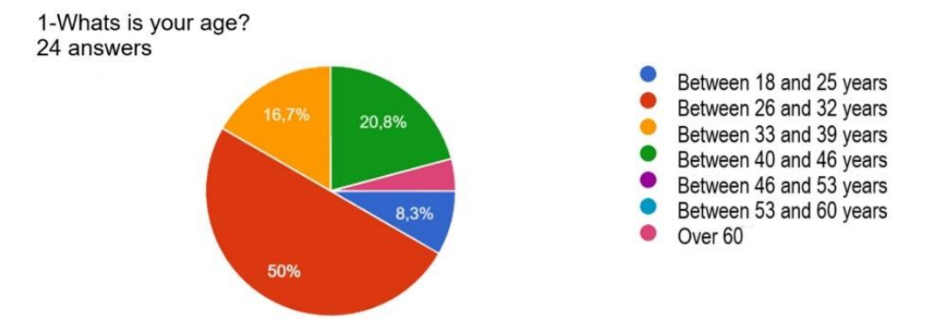
Figure 1
The majority of respondents (50%) are between 26 and 32 years old, followed by (20.8%) between 40 and 46 years old, and in third place (16.7%) between 33 and 39 years old, as shown in the chart in Figure 1.
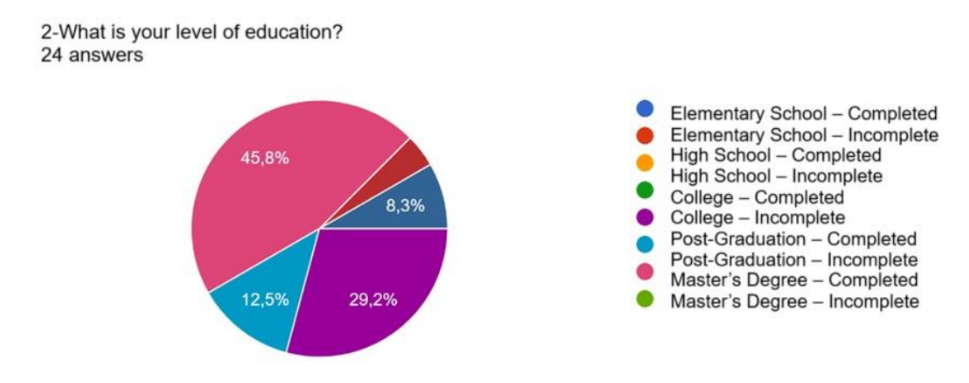
Figure 2
The majority of respondents (45.8%) have a postgraduate degree, followed by (29.2%) with a completed undergraduate degree, and in third place (12.5%) with an incomplete undergraduate degree, as shown in the chart in Figure 2.
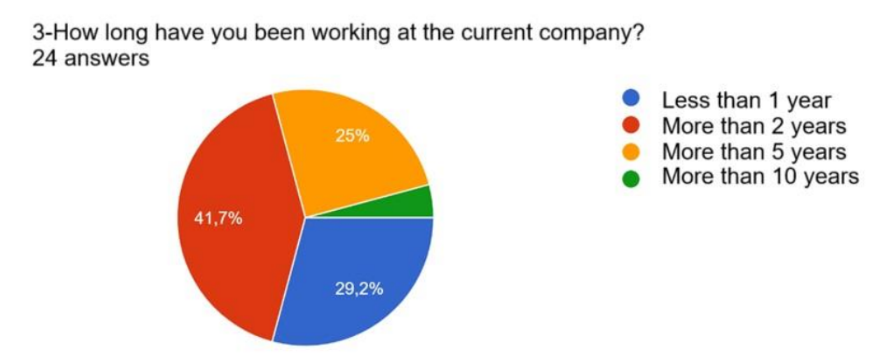
Figure 3
More than 40% of respondents have been working at their current company for over two years, which suggests that they already have a high level of knowledge regarding the communication channels and their importance within the company, as shown in the chart in Figure 3.
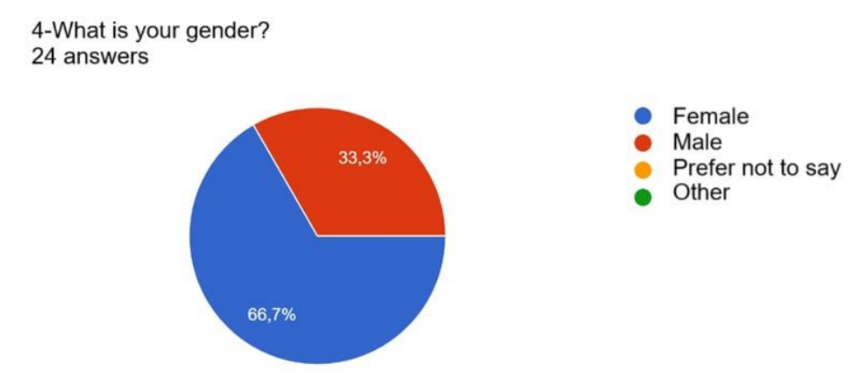
Figure 4
Among the respondents, 66.7% are female and 33.3% are male, as shown in the chart in Figure 4.
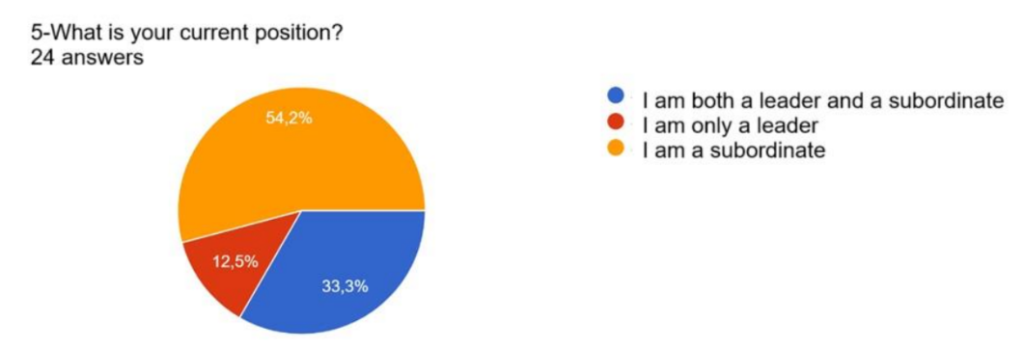
Figure 5
Among the respondents, 54.2% are only subordinates, 33.3% are both leaders and subordinates, and 12.5% are only leaders, as shown in the chart in Figure 5.
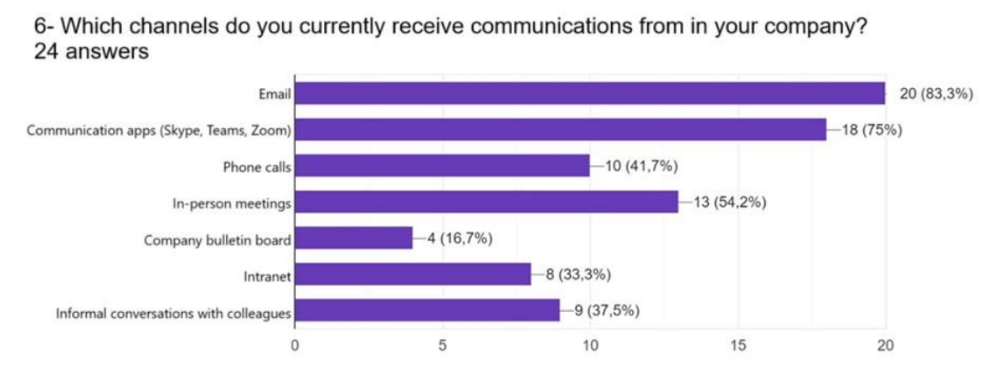
Figure 6
The majority of respondents (83.3%) receive communication mostly through email, followed by (75%) through communication apps, and in third place (54.2%) through in-person meetings, as shown in the chart in Figure 6.
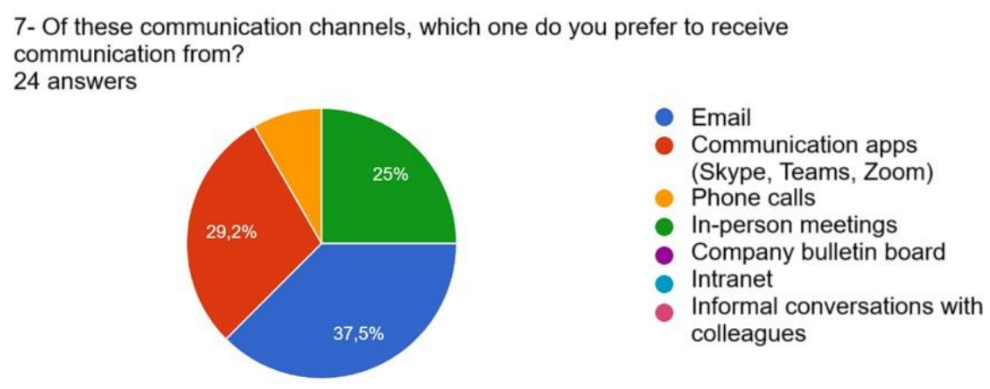
Figure 7
Among the communication channels through which respondents receive information, the most preferred is email (37.5%), followed by (29.2%) communication apps, and in third place (25%) in-person meetings, with phone calls being the least preferred, as shown in the chart in Figure 7.
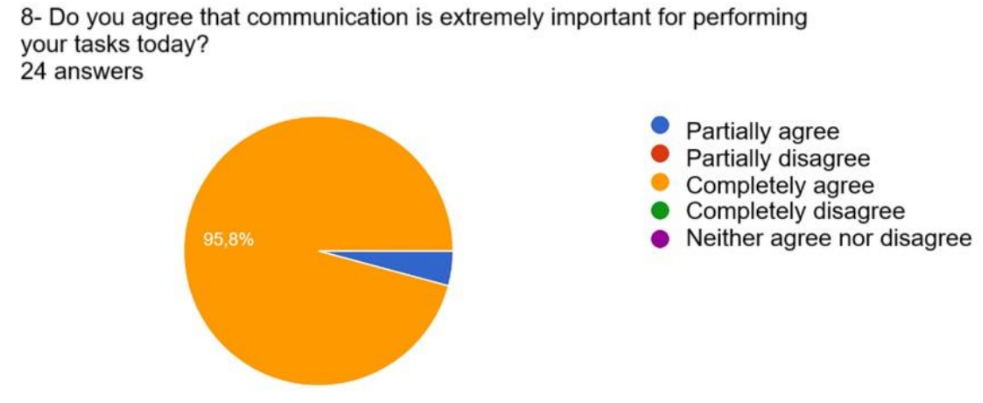
Figure 8
95.8% of respondents agree that communication is extremely important for carrying out their daily tasks, as shown in the chart in Figure 8.
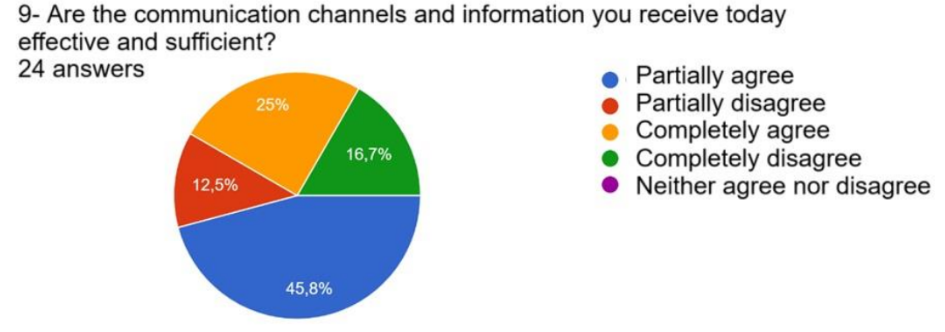
Figure 9
Only 25% of respondents completely agree that they receive effective and sufficient communication. The remaining 75% agree that there is a need for some improvement in the communication channels and information they receive today, as shown in the chart in Figure 9.
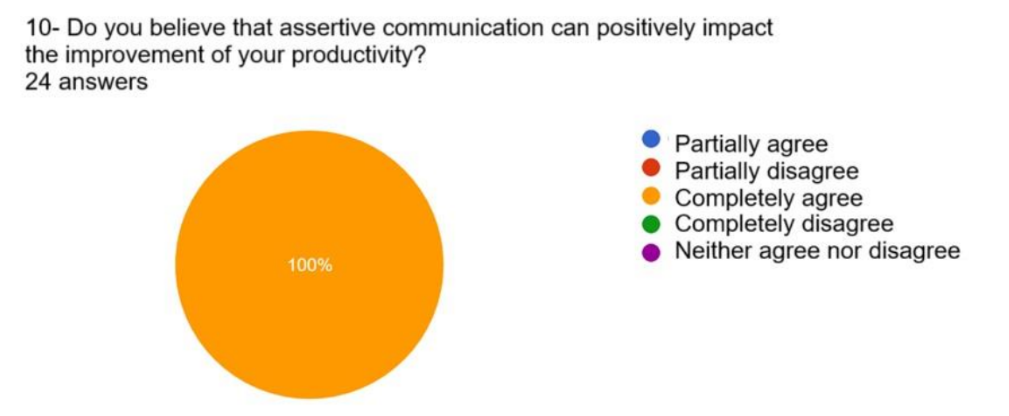
Figure 10
100% of respondents agree that assertive communication can positively impact the improvement of their productivity, consequently leading to improved results for the organization, as shown in the chart in Figure 10.
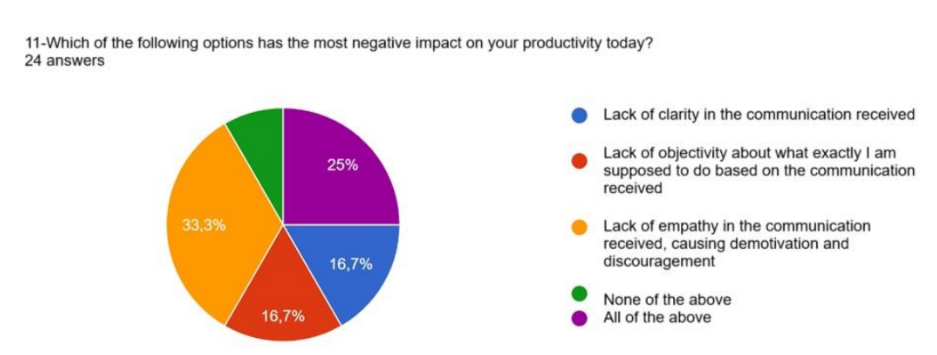
Figure 11
In first place, 33% of respondents indicated that the biggest negative impact on their productivity is the lack of empathy in the communication they receive, highlighting the need for leaders to improve their communication performance. It is not just the channel through which information is received, but also how it is conveyed, written, or presented. In second place, 25% of respondents agree that the lack of objectivity in what exactly they need to execute in the communication they receive negatively impacts their productivity, as well as the lack of clarity and empathy, as shown in the chart in Figure 11.
12- What are the main communication barriers for you?
Out of the 24 respondents, 16.7% pointed to the lack of empathy as the main barrier, 8.3% indicated that the lack of objectivity is the issue, and 12.5% identified the lack of clarity in the communication they receive.
13- If you believe there are communication failures, what changes and/or improvements would you suggest?
Out of the 24 respondents, only 1 did not suggest any improvements. Among the suggested improvements, the most notable were: transparency of organizational information, objectivity and clarity in communication, putting oneself in the other person’s shoes (empathy), also highlighting the positive aspects, and improving the way communications are delivered.
Conclusion
This research concluded that assertive communication is extremely important in organizations, not only for maintaining a positive workplace environment but also for its impact on the overall productivity of the organization.
It was also found that respondents prefer to receive communication via email and communication apps; however, they agreed that there is a lack of empathy, clarity, and objectivity in communication through these channels. This lack of assertiveness negatively impacts the productivity of subordinates and, consequently, the entire organization.
It was observed that 100% of respondents agree that assertive communication positively impacts the productivity of their tasks, proving how important it is for organizations to focus on training their employees in proper communication methods and investing in good communication channels.
The research results also concluded that there are barriers to communication, whether in the role of leader or subordinate, and that improvement measures could be taken, as it was confirmed that these issues negatively impact their activities. Thus, the pursuit of assertive communication is necessary to achieve the goals and objectives expected by the organization.
Acknowledgment
First, I want to thank God for my life. Secondly, I would like to thank my husband, who supported me throughout this time of dedication to the MBA and dissertation. I would also like to express my gratitude to my advisor, Ana Paula Dário Zocca, for all the guidance and teaching she provided to me and to this research. Lastly, but not least, I want to thank all the MBA Business Management professors at USP – ESALQ for each class, their time, and their dedication in teaching us with such excellence.
References
BURBRIDGE, A.; BURBRIDGE, M. Conflict Management. The Corporate World Challenge. Saraiva, 2012.
GENELOT, D. Managing in Complexity — Reflections for the Use of Leaders. 3rd ed. Paris: Insep Consulting, 2001.
BUENO, WILSON DE COSTA. Applied Social Sciences. Corporate Communication, 2014. MAXWELL, John C. Winning with People. Thomas Nelson Brasil, 2007.
FERREIRA, A. B. H. New Aurélio Dictionary of the Portuguese Language. São Paulo: Saraiva, 2010.
TAVARES, M. Corporate Communication and Communication Plans: Integrating Theory and Practice. 3rd ed. São Paulo: Atlas, 2010.
DAVIS, K.; NEWSTROM, J.W. Human Behavior at Work: An Organizational Approach. São Paulo: Cengage Learning, 1996. v. 2.
SILVA, R. P.; BONDIOLI, E. A.; LA CUEVA, J. F. Assertive Behavior in Negotiation Techniques. In: CONVIBRA ADMINISTRATION – BRAZILIAN VIRTUAL ADMINISTRATION CONGRESS, 7th ed., 2009, São Paulo. Proceedings… São Paulo, 2009.
1Commercial Manager. Rua roma 71 –Vila Romana – Zip Code 05050-090 – São Paulo (São Paulo), Brasil. * corresponding author.: bruna.ams@outlook.com
2MBA/ESALQ – Mestre em Administração – Street: Alexandre Herculano, 120, room T4 – Vila Monteiro – Zip Code 13.418-445 – Piracicaba (São Paulo), Brasil
